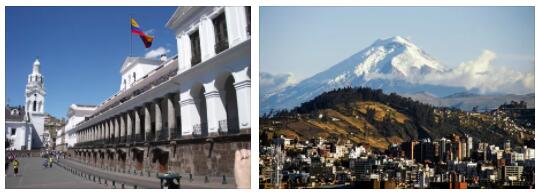Precolumbian era
The first records of known human settlements in the current Ecuadorian territory date from approximately 12,500 years ago. There are remains of the Paleoindian in Las Vegas, Chobsi, Cubilán and Amazonian cave paintings. In addition, there are multiple vestiges of points carved from obsidian, ceramics, use of metals and to a lesser extent constructions, the most relevant being those found in the northern highlands, such as the pyramids of Cochasquí and, on the coast, the tombs of the culture. La Tolita. At first, these regions were inhabited only by small populations of Indians until they became part of the great Inca empire.
Upon the arrival of the Incas, it is estimated that more than 46 peoples descended from the Minchaleños and Incarnacionillos inhabited Ecuador and the most numerous: Pastos, Caranquis, Imbayas, Paltas, Puruháes, Panzaleos, Cañaris, Quitus, Hambatus and others, who were subjected by the greater military power of the Incario and by regional pacts between the local monarchs and the delegates of the Inca. During the Incario, some settlements with foreign architecture were built, the most important being Ingapirca (a good part of the archaeological remains are still preserved) and Tumipampa (Tomebamba) (the city of Cuenca was founded on the latter although its ruins are preserved in some sectors). The permanence of this town was not greater than 60 years.
Spanish colonization
In 1534, the Spanish Sebastián de Benalcázar conquered the Ecuadorian lands. Once the capital, Quito, was taken, the largest pre-Hispanic population settlement in 1563, it was re-established as a Spanish city, capital of the Presidency of Quito and Royal Audience of Quito, forming part of the Viceroyalty of Peru.
The Spanish used not only the indigenous urban settlements as the basis for the new mestizo cities, but also used various elements of the autochthonous social structure to colonize the territories they occupied; the natives outnumbered them, but the Spaniards had greater military prowess and more powerful weaponry, for which they subdued the indigenous populations. The Incas, in addition to being in internal wars, were unaware of firearms. It is said that many indigenous people thought that the Spaniards who rode their horses were four-legged beings and compared the sound of cannons with that of thunder, but it did not take long for the indigenous people to begin to defend themselves despite their disadvantage.
In 1739, the Viceroyalty of New Granada was integrated together with Caracas, Panama and Santa Fé de Bogotá. Relations between the native population and the newcomers were governed by legal institutions such as the Mita and the Encomienda, the latter approved by the Laws of Burgos in 1512 for the defense of the Indians. Diseases like measles decimated the indigenous population. This caused that for the forced labor black African population was brought, as slaves, which contributed to the miscegenation of present-day Ecuador.
Independence and Greater Colombia
The first movements began in 1809 with the rebellion of the Criollos against Spanish rule known as the First Cry of American Independence.
After the French rule and with the refusal of the King of Spain, Fernando VII, to abide by the Constitution of Cádiz, a wave of independence movements was unleashed in Spanish America. Thus the old Presidency and Hearing of Quito gets secede from the metropolis in the Battle of Pichincha of the 24 of maypole of 1822, thanks to the triumph of the Mariscal Antonio Jose de Sucre, lieutenant of Simon Bolivar.
According to andyeducation, the territories of Quito and Guayaquil became part of Greater Colombia under the name of the Southern District. The collapse of the new republic led to the formation of the sovereign states of Nueva Granada (present-day Colombia and Panama), Venezuela, and Ecuador in 1830.
When in 1822 the independence army, commanded by Antonio José de Sucre, defeated the royalist forces in the Battle of Pichincha, the territories became part of Gran Colombia. Since 1830, the year of the end of Gran Colombia, the nations of: Ecuador, Colombia, Venezuela and Panama maintained their political and economic nexus as they continued as federated states for 5 more years.
